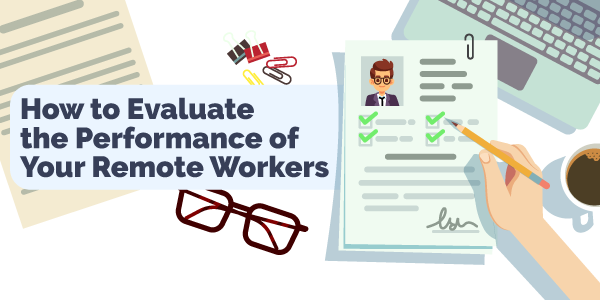
The past few months have been difficult for everyone, but more so for the country’s workforce. Due to the health risks and organizational challenges brought upon by COVID-19, businesses have been forced to revamp their work arrangements, such as having staggered schedules or embracing a remote work setup.
If your company has chosen the latter, then you’ve probably encountered difficulties concerning remote management. Supervising your team during this time is extra hard due to the lack of physical contact.
However, trusting them shouldn’t mean that you should be lenient. After all, working from home doesn’t mean fewer responsibilities than working in the office. If you want your employees to stay motivated and productive, you need to set the necessary standards and conduct performance assessments.
The graphic below will discuss how you can properly evaluate the performance of your remote workers in a few simple steps.

Due to innovations in technology and developments in global office culture, working from home has become the new norm. As of 2020, research estimates that over 5 million employees are working remotely, and trends suggest that this figure will continue to rise in the years to come. Given that a vaccine is still in development, it will take some time before employees can go back to regular office life.
As your organization continues to adjust to the demands of the pandemic, it’s natural to face operational challenges along the way. Apart from absorbing new talent or improving team collaboration, a remote setup may give you some trouble when assessing the performance of your employees.
Since government regulations and safety concerns prevent you from overseeing your team directly, evaluating your staff can get very challenging. Fortunately, modern communication tools, paired with the best practices in remote management, will allow you to assess your employees effectively.
How to Measure Remote Work Productivity
1. Set clear objectives and goals
Measuring employee performance starts by setting the right standards. Given your employees’ current competencies, you’ll need to set clear and realistic goals so they have a better idea of what they should improve on. Once the assessment period has begun, comparing their performance against the metrics set will allow you to evaluate them objectively.
2. Use a tracking tool
Task management software or time tracking applications are valuable investments when it comes to remote work management. In terms of performance evaluations, these tools can provide statistical data regarding the efficiency of your team members. From a productivity standpoint, they come with certain features that can improve the employees’ work output.
3. Value output than input
Unlike in the office where you can easily observe your team, a remote working setup will require you to trust everyone. Since you can’t watch over them, some employees may be doing things unrelated to work or fall into different kinds of distractions. As this factor isn’t under your control, you should focus more on their output instead of their methods.
At the end of the day, it’s the deliverable that matters. Your employees may be dealing with other things in their household, but as long as the end product they submit meets the necessary standards, there shouldn’t be any problem.
4. Gather feedback from everyone they work with
If you want a better picture of how well a specific employee is performing, you should gather feedback from the people he/she has worked or is working with. The ones he/she collaborates with the most should be more aware of his/her strengths and tendencies.
Now that you’re adopting a remote setup, collaborators should make up for the lack of contact and serve as your second set of eyes and ears.
5. Ask them for a self-evaluation
Self-evaluation can be beneficial in several ways. It gives you the chance to know how your employees view themselves and helps you understand them better to strategize your approach as a manager. At the same time, you can use their ratings and compare them to their colleagues’ feedback to give you a clearer idea of his performance.
Tips for Doing Remote Performance Evaluation
1. Do real-time feedback if you can
If you want to see improvements fast, then provide real-time feedback. Don’t wait for reviews to give constructive criticism. Comments given frequently and on a timely basis are more effective in instilling behavioral improvements, and adopting this practice with your employees can even improve your day-to-day communications.
2. Look at the performance more than anything else
Focus on the behavior rather than the person. Whether it’s a direct or remote assessment, always stay objective when evaluating your employees. You may be friendly toward certain colleagues, but remember to keep biases and other distractions at bay. A professional mindset will ensure that your assessments are accurate and fair.
3. Set up one-on-ones
Virtual hangouts may not be as good as a discussion over coffee, but it’s incredibly important during this period. Performance assessment shouldn’t be a one and done thing, so regularly setting up one-on-one sessions will ensure that your employees are always taking steps towards development.
Other than helping you measure their performance, habitually checking up on your employees can nurture your working relationship with them, as well.
4. Recognize different strengths/competencies
Even though assessment periods are meant to emphasize points for improvement, it’s essential to recognize strong points as well. Each employee has something to bring to the table, and as a manager, you’re in charge of nurturing that strength.
If you like how an employee handles clients or collaborates with other departments, letting him/her know that his/her methods are recognized and effective will reinforce this positive behavior.
5. Have a two-way communication
Communication is a two-way street, so don’t dominate the conversation. You may be the one leading the evaluation, but this doesn’t mean that you shouldn’t let your employee speak up. Knowing what they feel about work, projects, and the company won’t only help you foster their development, you can also gain insights into how you can improve as a manager, as well.
Sample Questions You Can Ask
Adjusting to a new setup isn’t as easy as it sounds. Since your employees have their work preferences, you can expect each of them to react differently to telecommuting. Given that the working environment can significantly affect productivity, it’s possible to see a decline in their performance.
As you evaluate the performance of your workers, you should also allow them to speak their minds concerning the new setup. Taking note of the roadblocks they face and how you can make things easier will help you optimize their performance during this period. Here are some questions you can ask.
- How are you adapting to working remotely?
- What challenges are you currently facing at home?
- How do you feel about the communication channels for work? What are the difficulties you encounter when connecting with your colleagues?
- How is your emotional well-being? How do you manage your stress throughout the day?
- What does your work setup look like? Do you have the necessary tools and equipment?
- What are the distractions preventing you from performing at your best?
Working from home has a ton of benefits, but it’s important to recognize that it also comes with challenges. Apart from being apart from colleagues and not being able to perform tasks in a professional atmosphere, staying in isolation and blurring the line between your professional and personal life can be an emotionally draining experience.
Knowing how you can make things easier for them won’t just improve performance; it will also help them maintain their well-being and keep quarantine fatigue at bay.
Adopt the Best Practices of Remote Management
The world is about to shift to a new normal. As your business continues to adapt to the effects of the pandemic, knowing the best practices in remote management will allow you to overcome any operational issues that may come your way. Measuring and improving the performance of your employees will be ten times easier now that you have these tips in mind.
Having some trouble adjusting? We’ve got you covered. Manila Recruitment provides remote working solutions to help you fully transition to a remote work setup in the Philippines. We’ll be glad to provide all the assistance you need. Contact us today for more details!













